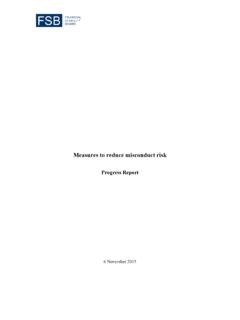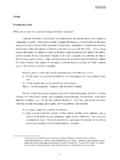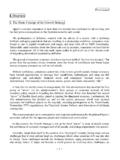Transcription of India insurance - EY
1 India insurance : industry developments fostering positive market sentiment Table of contents The Indian economy is one of the most attractive destinations in the emerging markets for insurance investment given that its sheer size and low level of penetration offer huge growth potential. The industry is currently the 15th-largest world market, with a total premium of US$60b in 2014. Executive summary 2. India insurance market, unprecedented growth 4. Evolving regulatory lanscape 6. Striding through the current challenges 8. Increased FDI limits change the face of insurance 10. Future enablers and trends 14. Conclusion 17. Abbreviations used 18. Appendix 18. Contacts 20. B India insurance : industry developments fostering positive market sentiment 1. Executive summary Ever since the industry opened to FDI of up to 26% in 2000, the country has seen increasing interest and participation by foreign players including the largest insurance companies from the UK, Japan, Europe and the US.
2 Competition, evolving regulation and dynamic market conditions also have played a dominant role in shaping the industry . In response to slower growth rates and penetration Data analytics: insurers are keen about leveraging levels, which have not increased in the last few years, the predictive power and optimization opportunities the Government announced a second round of reforms, presented by data analytics across functions. including the insurance Laws (Amendment) Bill, Innovative distribution models: the trends around 2015, which allows a composite foreign investment mobile and online channels have been phenomenal, cap of 49%. This is expected to play a pivotal role mandating the need for adoption by insurers, along in improving penetration levels. It also will enable with segment-focused channel setups and other insurers to reinforce growth prospects by investing sourcing models emanating from alliances and other in their managerial capabilities, technical knowledge, sector tie-ups.
3 Distribution network, administration and innovation Digital revolution: given the extensive use of in products and processes. internet-driven solutions in developed markets, In addition, there are several trends and future there is a visible inclination by local insurers toward enablers that will facilitate unlocking the full potential digital and mobile solutions to lower customer of the industry , including : acquisition and servicing costs and provide improved Renewed focus on profitability: initial steps toward access to information and convenience. this journey have already been taken by the industry , In this report, we explore how unprecedented growth with a focus on customer retention, leaner branch in this market and changing legislation are presenting structures and supply chain efficiencies. challenges for the industry .
4 We discuss why India is The Indian economy is one of the most attractive destinations in the emerging an attractive choice for business expansion and how Customer-centricity: creation of customer-centric markets for insurance investment given that its sheer size and low level of penetration operating models, direct to consumer, to reduce insurers can capitalize on opportunities to unlock the offer huge growth potential. The industry is currently the 15-th largest world market, dependency on intermediaries and adoption of full potential of their businesses. technology are the key improvement levers for with a total premium of US$60b in 2014. Though marked by slower growth rates insurers to work toward. in the last few years (6% from fiscal year [FY] 2010 to FY 2014, compared with Health ecosystem: increasing awareness levels, 23% from FY 2001 to FY 2010), the industry currently stands at a critical juncture inflationary health care costs and fast progression of of its evolution.
5 Transformational reforms are being led by a stable government, medical technology mandate creating an ecosystem in collaboration with the health care sector, insurers, which is indicative of a revival of growth momentum. The new government has regulators, government and customers. allowed an increase in foreign direct investment (FDI) limits one of the landmark developments in the industry that is fostering positive market sentiment. 2 India insurance : industry developments fostering positive market sentiment 3. 11. India th insurance market, unprecedented growth India is the world's 11th-largest life insurance market and the 5th-largest in the Asia-Pacific Region; in nonlife, it ranks 21st in the world and 6th in the Asia-Pacific Region. This success can be attributed to significant growth over the last decade, driven by a developing economy, lucrative tax benefits, a growing middle class, rising disposable incomes and increased awareness about the need for insurance .
6 In the life insurance space, 75% of the market share Nonlife insurance has grown exponentially, reaching is held by the sole Government-owned insurer of the double digits in almost all years since the sector country with an extensive distribution network and started in 1999. Traditionally, the nonlife market has a trusted brand image. The life insurance industry been dominated by motor vehicle insurance due to registered an impressive 29% CAGR between FY 2001 mandatory third-party (TP) liability, which constituted and FY 2011. The industry growth rate was negative 48% of the total nonlife insurance premium in FY. in FY 2012 and stagnated in FY 2013 due to a slew of 2014. This was followed by health and fire coverage regulations requiring insurers to revamp their business at 22% and 10%, respectively. models, change product structures and move toward As the life and nonlife sector has gone through this more cost-efficient operations.
7 This was the period transition during the last 14 years, there were several when the industry witnessed a shift in the product mix drivers that laid the building blocks and foundation from linked to non-linked, traditional products. for growth (see Appendix 1). The insurance industry has witnessed phases of both rapid and moderate growth. Regulatory reforms, the changing economic landscape, the need for profitable growth and changing customer needs have been the key drivers of this oscillating journey. 4 India insurance : industry developments fostering positive market sentiment 5. Evolving regulatory landscape In spite of this, recent regulatory developments have shown a progressive outlook that focuses on the interests of all stakeholders, as follows: Increase FDI limits as part of the new insurance bill, Develop insurance marketing firms (IMFs) as a which is expected to help insurers with more capital new distribution channel.
8 This is expected to give and technical know-how. distributors (especially agents) a logical career Promote an open architecture by allowing banks progression and reduce chances of mis-selling to to operate as brokers and mandating that every customers by adopting a more professional outlook. corporate agent have more than one insurance A summary of the key regulations that have impacted partner in each life, health and general insurance the insurance industry is shown in Figure 1. category. This could help nonbank insurance players enter into bancassurance relationships and provide customers more choices. Figure 1: The impact of regulation over the past 10 years 2013 2014 2015. Regulation Capping of Clari cation on Health insurance Banks to operate as Increased FDI limits commissions on pension products product regulations brokers Development of unit-linked insurance guidelines of 2010 and standardized Revised product insurance marketing plan (ULIP) scrapping the de nitions regulations for life rms Declined riskpool for guaranteed annual with minimum death Proposal to make motor (TP) return clause on ULIP bene t speci cation motor TP premium with a nonzero-return market-driven Health insurance clause portability Impact Disincentivized Most private players Better understanding Greater choice for Capital infusion Regulatory changes in the insurance sector have also played a dominant role in.
9 Agents . had withdrawn their . of terms by the . the customers . to aid in improved linked pension customer, reducing quality and expanding shaping the industry , from both a growth and profitability perspective. For example, Customers shifted products in 2010 the risk of mis-selling Non-bank tied up reach from ULIP to players to get new the introduction of a cap on product charges had a significant impact on the life insurance traditional products For the rst three quarters of FY12, Increased access to reliable health care opportunities Much needed career progression for agents Non-pro table Products re-priced only LIC had a data for insurers industry while the general insurance sector was affected by price de-tariffication branches were shut pension product and re- led Higher prudence on Improved pro tability selection of risks and motor products were susceptible to TP risk-pooling arrangements.
10 Of motor TP line of business Flexibility for customers necessitated servicing 6 India insurance : industry developments fostering positive market sentiment 7. Striding through the current challenges The industry continues to grapple with several issues, led by macroeconomic factors as well as structural changes intrinsic to the industry . Some of the current challenges that the industry is overcoming are: Low level of customer awareness: life insurance Heavy cost and capital burn: in an endeavor to is a long-term financial security product. However, in capture market share and diversify their reach, most India , the lack of adequate awareness has led to stiff insurers have focused on topline growth. The lack of competition from banks, advisors and other investors focus on profits has resulted in inefficient operating that generate higher returns in the shorter term.

















